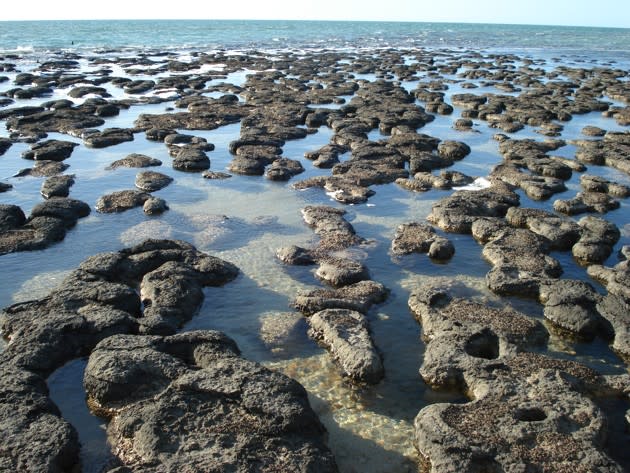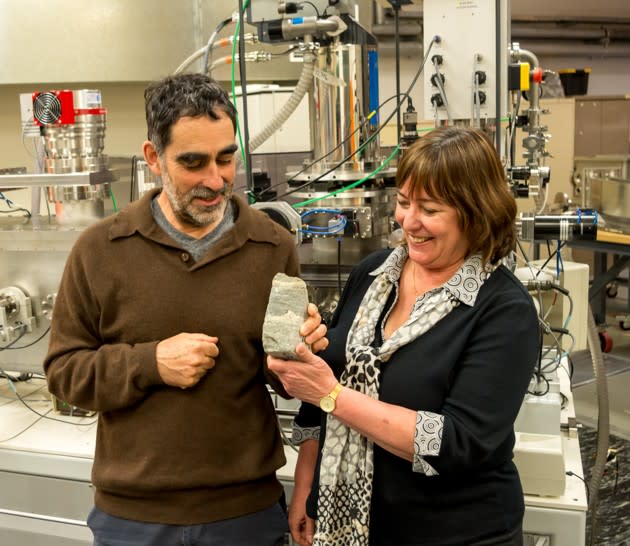The World’s Oldest Fossils Are 3.7 Billion Years Old
The southwest corner of Greenland is a barren place. Most of the time, the only living things you can see are moss and lichen. Occasionally though, you might also spot a few scientists, who have come to study the rocks of this desolate landscape, which happen to be among the oldest on Earth. They were created around 3.7 billion years ago, when our 4.5-billion-year-old planet was still in its childhood.
A few years ago, geologists Allen Nutman, Vickie Bennett, and Clark Friend were studying these ancient rocks when they noticed a few new outcrops that had been recently uncovered by melting snow. They walked over to one, and quickly found something unexpected: flat layers of rock with conical humps rising out of them. “All of us suddenly thought: ‘AH! We know what we think these are!’” recalls Nutman. “We were very excited.”
The trio realized that the structures looked exactly like stromatolites—layered structures created by communities of ancient bacteria. These microbes lived in large mats, which produced sticky mucus that trapped sand grains and minerals. As the bacteria continued growing, they moved upwards, leaving layers of minerals in their wake. Over time, those minerals hardened into domes and mounds. That’s what stromatolites are: fossilized bits of bacterial architecture.
“Life is not a fussy, reluctant and unlikely thing. Give life half an opportunity and it’ll run with it.”
Until now, the oldest known stromatolites came from Western Australia, and were 3.48 billion years old. They represented the earliest convincing evidence of life on Earth. And the structures that Nutman, Bennett, and Friend discovered in Greenland are 3.7 billion years old—220 million years older than the Australian ones. If the trio are reading them correctly, and they really were produced by bacteria, then they are easily the oldest fossils ever found.
If you condense the entire history of the Earth into a single calendar year, then the bacteria that created the Greenland fossils were alive in the second week of March. And since they were already sophisticated, capable of forming large colonies, life itself must have arisen much earlier, perhaps sometime in mid-February.
Recommended: Apeirophobia: The Fear of Eternity
The implication is that once the Earth was born, it didn’t take long for life to get going. As NASA geologist Abigail Allwood writes in an accompanying commentary, “The cradle of life [might have been] ready and rocking when Earth itself was but an infant.”
Stromatolites have long been controversial. Natural processes can produce structures that look very similar to stromatolites, and many scientists have become embroiled in long debates about whether a given bit of rock was really the work of microbes. Regardless, it’s commonly accepted that the oldest known stromatolites are from the Pilbara region of Western Australia, and are 3.5 billion years old.

It seemed unlikely that researchers would find older ones, given that there are few other sites on Earth where older rocks actually exist. Western Greenland—and especially a coastal site called the Isua Greenstone Belt—is an exception, but still a problematic one. Its rocks are certainly ancient, but they’ve also been put through the wringer, warped and distorted by intense heat and pressure. They seemed unlikely to preserve the clean layers and shapes that make stromatolites so distinctive.
At first, Nutman and others searched the Greenland rocks for alternative signs, like chemical signatures that could betray the activity of living things. They found a few such signatures, but none made for a slam-dunk case. “The chemical evidence could be interpreted as signs of life, but there’s always been some element of doubt,” says Nutman. “But what we have now is something very different—something tangible and visible you can see, rather than a reading that’s come out of an instrument.”
Recommended: What Trump Gets Right About Illegal Immigration
His team found what they think are stromatolites in three separate outcrops. These patches of rock are small, and like everything else in the region, they’ve been heavily distorted. Still, the team managed to check off a long checklist of criteria that they think firmly identify them as stromatolites. For example, there’s their shape—steep-sided cones or domes that look very much like the Pilbara stromatolites and unlike any structures formed through physical processes alone. These shapes represent stromatolites poking out of shallow water, as sand piles up against their sides.
They also differ from the rock around them in their structure and chemistry—for example, they contain fine layers, and high concentrations of titanium and potassium. They also harbor levels of yttrium and other rare elements that are consistent with seawater. Again, this suggests that they’re not simply portions of rock that have been folded into stromatolite-esque shapes. Instead, they’re the work of microbes, growing in a shallow ocean. “When we look at these rocks, we’re getting a wonderful fortuitous snapshot of a very ancient time,” says Nutman.

Nutman is “a very careful worker,” says Nora Noffke, a geologist who studies microbial mats. She’s on the fence about what these new structures are, given the poor quality of the preserving rock, but she’s also optimistic that the Isua Greenstone Belt will yield clearer fossil evidence for early life.
Interpreting such structures will always be controversial, but their very existence is a good sign, adds astrobiologist Dorothy Oehler. It suggests that there might be even better preserved pockets of rock in the same region, “where further potential evidence of such early life may be discovered.”
Recommended: How Instagram Opened a Ruthless New Chapter in the Teen Photo Wars
If Nutman is right that he has found stromatolites, microbes were already living in large and perhaps cooperative communities by 3.7 billion years ago. “It suggests a certain sophistication of life, and that life originated significantly before that point,” he says. This fits with the chemical evidence that he and others had already discovered in Greenland. And it fits with evidence from genetic studies, suggesting that the universal ancestor of all living things lived around 4 billion years ago. By the time the Greenland bacteria were making stromatolites, “life already had a considerable prehistory,” Nutman says.
“The implications are staggering,” Allwood writes. It means that life arose surprisingly quickly after the Earth was formed. It then persisted through a period 3.7 billion years ago, when the young Earth was regularly pelted by asteroids. “If life could find a foothold here, and leave such an imprint that vestiges exist… then life is not a fussy, reluctant and unlikely thing. Give life half an opportunity and it’ll run with it.”
Perhaps it did so on other worlds, too. While the Greenland stromatolites were forming, Mars was still a wet planet. “If life could have evolved so quickly on earth, there’s no reason why it couldn’t have evolved on Mars, which raises the possibility of detecting signs ancient life on Mars,” says Nutman. Maybe the rovers of the future will beam back pictures of Martian stromatolites.
Read more from The Atlantic:
This article was originally published on The Atlantic.

